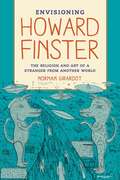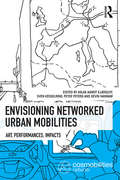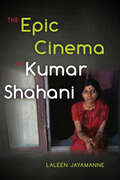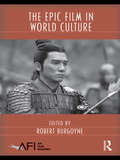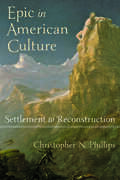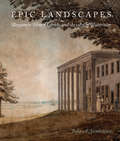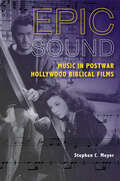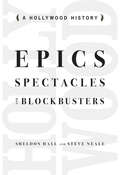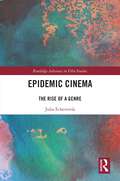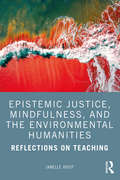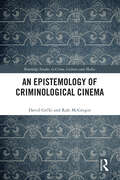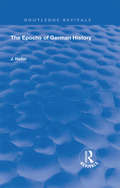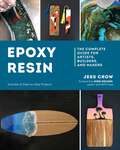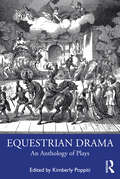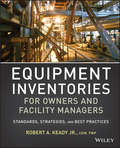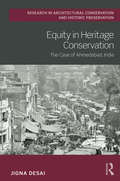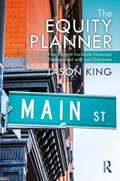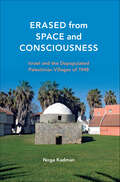- Table View
- List View
Envisioning Howard Finster: The Religion and Art of a Stranger from Another World
by Norman GirardotThis book explores the life and religious-artistic significance of Finster and his work from the personal perspective of religion scholar Norman Girardot, friend to Finster and his family during the later years of the artist’s life.
Envisioning Howard Finster: The Religion and Art of a Stranger from Another World
by Norman J. GirardotThe Reverend Howard Finster (1916–2001) was called the "backwoods William Blake" and the "Andy Warhol of the South," and he is considered the godfather of contemporary American folk and visionary art. This book is the first interpretive analysis of the intertwined artistic and religious significance of Finster’s work within the context of the American "outsider art" tradition. Finster began preaching as a teenager in the South in the 1930s. But it was not until he received a revelation from God at the age of sixty that he began to make sacred art. A modern-day Noah who saw his art as a religious crusade to save the world before it was too late, Finster worked around the clock, often subsisting on a diet of peanut butter and instant coffee. He spent the last years of his life feverishly creating his environmental artwork called Paradise Garden and what would ultimately number almost fifty thousand works of "bad and nasty art." This was visionary work that obsessively combined images and text and featured apocalyptic biblical imagery, flying saucers from outer space, and popular cultural icons such as Elvis Presley, Marilyn Monroe, Henry Ford, Mona Lisa, and George Washington. In the 1980s and 90s, he developed cult celebrity status, and he appeared in the Venice Biennale and on the Tonight Show. His work graced the album covers of bands such as R.E.M. and Talking Heads. This book explores the life and religious-artistic significance of Finster and his work from the personal perspective of religion scholar Norman Girardot, friend to Finster and his family during the later years of the artist’s life.
Envisioning Networked Urban Mobilities: Art, Performances, Impacts (Networked Urban Mobilities Series)
by Kevin Hannam Sven Kesselring Aslak Aamot Kjaerulff Peter PetersEnvisioning Networked Urban Mobilities brings together scientific reflections on the relations of art and urban mobilities and artistic research on the topic. The editors open the book by setting out the concept grounded in the exhibition curated by Aslak Aamot Kjærulff and refers to earlier work on mobilities and art generated by the Cosmobilities Network. This third volume has two sections, both consisting of short papers and illustrations. The first section is based on artists who were part of the conferences' art exhibition, and the second part is based on theoretical reflections on art and artists.
Envisioning New Jersey: An Illustrated History of the Garden State
by Richard F. Veit Maxine N. LurieSee New Jersey history as you read about it! Envisioning New Jersey brings together 650 spectacular images that illuminate the course of the state's history, from prehistoric times to the present. Readers may think they know New Jersey's history--the state's increasing diversity, industrialization, and suburbanization--but the visual record presented here dramatically deepens and enriches that knowledge. Maxine N. Lurie and Richard F. Veit, two leading authorities on New Jersey history, present a smorgasbord of informative pictures, ranging from paintings and photographs to documents and maps. Portraits of George Washington and Molly Pitcher from the Revolution, battle flags from the War of 1812 and the Civil War, women air raid wardens patrolling the streets of Newark during World War II, the Vietnam War Memorial--all show New Jerseyans fighting for liberty. There are also pictures of Thomas Mundy Peterson, the first African American to vote after passage of the Fifteenth Amendment; Paul Robeson marching for civil rights; university students protesting in the 1960s; and Martin Luther King speaking at Monmouth University. The authors highlight the ethnic and religious variety of New Jersey inhabitants with images that range from Native American arrowheads and fishing implements, to Dutch and German buildings, early African American churches and leaders, and modern Catholic and Hindu houses of worship. Here, too, are the great New Jersey innovators from Thomas Edison to the Bell Labs scientists who worked on transistors. Compiled by the authors of New Jersey: A History of the Garden State, this volume is intended as an illustrated companion to that earlier volume. Envisioning New Jersey also stands on its own because essays synthesizing each era accompany the illustrations. A fascinating gold mine of images from the state's past, Envisioning New Jersey is the first illustrated book on the Garden State that covers its complete history, capturing the amazing transformation of New Jersey over time.View sample pages (http://issuu.com/rutgersuniversitypress/docs/lurie_veit_envisioning_sample)Thanks to the New Jersey Historical Commission, the New Jersey Council for the Humanities, and generous individual donors for making this project possible.
The Epic Cinema of Kumar Shahani
by Laleen JayamanneThe Epic Cinema of Kumar Shahani examines the major works of leading Indian film director Kumar Shahani and explores the reaches of modernist film aesthetics in its international form. More than an auteur study, Laleen Jayamanne approaches Shahani's oeuvre conceptually, as films that reveal cinema's synesthetic capabilities. As the author illustrates, Shahani's cinematic project entails a modern reformulation of the ancient oral tradition of epic narration and performance in order to address the contemporary world, establishing a new cinematic expression. As evidenced by his films, constructing cinematic history entails more than an archival project of retrieval and is a living history of the present, which can intervene in the current moment through sensory experiences.
Epic Cosplay Costumes: A Step-by-Step Guide to Making and Sewing Your Own Costume Designs
by Kristie GoodThe Ultimate Guide to Cosplay, Costumes and Conventions! Presented in a kitschy, comic-book style, Epic Cosplay Costumes combines fantabulous illustrations with all the how-to information you need for creating your own cosplay designs. Award-winning artist Kristie Good (aka Karmada) shares techniques for making must-have pieces to mix and match into original costumes--from hand-sewn garments to armor made with Worbla and EVA foam. In addition to her step-by-step instructions for pulling together attention-grabbing designs, she shares expert advice for making the most of conventions, striking a pose, and strutting your stuff at costume competitions. Whether you're a hero, heroine, villain, or sidekick, Kristie gives you the power to create the most talked-about designs with Epic Cosplay Costumes!KAPOW!
The Epic Film: Myth and History (Routledge Library Editions: Cinema)
by Derek ElleyAs Charlton Heston put it: ‘There’s a temptingly simple definition of the epic film: it’s the easiest kind of picture to make badly.’ This book goes beyond that definition to show how the film epic has taken up one of the most ancient art-forms and propelled it into the modern world, covered in twentieth-century ambitions, anxieties, hopes and fantasies. This survey of historical epic films dealing with periods up to the end of the Dark Ages looks at epic form and discusses the films by historical period, showing how the cinema reworks history for the changing needs of its audience, much as the ancient mythographers did. The form’s main aim has always been to entertain, and Derek Elley reminds us of the glee with which many epic films have worn their label, and of the sheer fun of the genre. He shows the many levels on which these films can work, from the most popular to the specialist, each providing a considerable source of enjoyment. For instance, spectacle, the genre’s most characteristic trademark, is merely the cinema’s own transformation of the literary epic’s taste for the grandiose. Dramatically it can serve many purposes: as a resolution of personal tensions (the chariot race in Ben-Hur), of monotheism vs idolatry (Solomon and Sheba), or of the triumph of a religious code (The Ten Commandments). Although to many people Epic equals Hollywood, throughout the book Elley stresses debt to the Italian epics, which often explored areas of history with which Hollywood could never have found sympathy. Originally published 1984.
The Epic Film in World Culture (AFI Film Readers)
by Robert BurgoyneWith the recent release of spectacular blockbuster films from Gladiator to The Lord of the Rings trilogy, the epic has once again become a major form in contemporary cinema. This new volume in the AFI Film Readers series explores the rebirth of the epic film genre in the contemporary period, a period marked by heightened and conflicting appeals to national, ethnic, and religious belonging.The orginal essays in this volume explore the tension between the evolving global context of film production and reception and the particular provenance of the epic as an expression of national mythology and aspirations, challenging our understanding of epics produced in the present as well as our perception of epic films from the past. The contributors will explore new critical approaches to contemporary as well as older epic films, drawing on ideas from cultural studies, historiography, classics, and film studies.
Epic in American Culture: Settlement to Reconstruction
by Christopher N. PhillipsThe epic calls to mind the famous works of ancient poets such as Homer, Virgil, and Ovid. These long, narrative poems, defined by valiant characters and heroic deeds, celebrate events of great importance in ancient times. In this thought-provoking study, Christopher N. Phillips shows in often surprising ways how this exalted classical form proved as vital to American culture as it did to the great societies of the ancient world.Through close readings of James Fenimore Cooper, Lydia Sigourney, Henry Wadsworth Longfellow, and Herman Melville, as well as the transcendentalists, Phillips traces the rich history of epic in American literature and art from early colonial times to the late nineteenth century. Phillips shows that far from fading in the modern age, the epic form was continuously remade to frame a core element of American cultural expression. He finds the motive behind this sustained popularity in the historical interrelationship among the malleability of the epic form, the idea of a national culture, and the prestige of authorship—a powerful dynamic that extended well beyond the boundaries of literature.By locating the epic at the center of American literature and culture, Phillips’s imaginative study yields a number of important finds: the early national period was a time of radical experimentation with poetic form; the epic form was crucial to the development of constitutional law and the professionalization of visual arts; engagement with the epic synthesized a wide array of literary and artistic forms in efforts to launch the United States into the arena of world literature; and a number of writers shaped their careers around revising the epic form for their own purposes. Rigorous archival research, careful readings, and long chronologies of genre define this magisterial work, making it an invaluable resource for scholars of American studies, American poetry, and literary history.
Epic Landscapes: Benjamin Henry Latrobe and the Art of Watercolor
by Julia A. SienkewiczWinner of College Art Association’s Wyeth Foundation for American Art Publication Grant Epic Landscapes is the first study devoted to architect Benjamin Henry Latrobe’s substantial artistic oeuvre from 1795, when he set sail from Britain to Virginia, to late 1798, when he relocated to Pennsylvania. Thus, this book offers the only extended consideration of Latrobe’s Virginian watercolors, including a series of complex trompe l’oeil studies and three significant illustrated manuscripts. Though Latrobe’s architecture is well known, his watercolors have received little critical attention. Epic Landscapes rediscovers Latrobe’s watercolors as an ambitious body of work and reconsiders the close relationship between the visual and spatial sensibility of these images and his architectural designs. It also offers a fresh analysis of Latrobe within the context of creative practice in the Atlantic world at the end of the eighteenth century as he explored contemporary ideas concerning the form of art for Republican society and the social impacts of revolution.
Epic Sound: Music In Postwar Hollywood Biblical Films
by Stephen C. MeyerLavish musical soundtracks contributed a special grandeur to the new widescreen, stereophonic sound movie experience of postwar biblical epics such as Samson and Delilah, Ben-Hur, and Quo Vadis. In Epic Sound, Stephen C. Meyer shows how music was utilized for various effects, sometimes serving as a vehicle for narrative plot and at times complicating biblical and cinematic interpretation. In this way, the soundscapes of these films reflected the ideological and aesthetic tensions within the genre, and more generally, within postwar American society. By examining key biblical films, Meyer adeptly engages musicology with film studies to explore cinematic interpretations of the Bible during the 1940s through the 1960s.
Epics, Spectacles, and Blockbusters: A Hollywood History
by Steve Neale Sheldon HallConsiders the history of the American blockbuster--the large-scale, high-cost film--as it evolved from the 1890s to today.
Epidemic Cinema: The Rise of a Genre (Routledge Advances in Film Studies)
by Julia EcheverríaThis book examines the recent trend in global cinema to feature infectious disease. As the global crisis of the COVID-19 pandemic materialised the anxieties and discourses of world risk that had long been portrayed in popular media, the book provides a novel definition of the epidemic film genre and offers a systematic look into the narrative and stylistic conventions that characterise it. Epidemic Cinema traces the evolution of the genre from its early cinematic origins to establish the founding principles of a genre standing at the crossroads between science-fiction and horror. It draws on close textual analysis to show how the pandemic reified one of the central predicaments of epidemic narratives: the constant tension existing between free-floating phenomena and the impulse to control and resist such phenomena, ultimately epitomised by the trope of the border. Showing how infectious diseases offer a rich allegorical frame which cinema uses to articulate timely anxieties of growingly invisible and deterritorialised risks, the author presents the prevalence of contagion in popular culture as a symptom of this growingly viral and virus-ridden context, both in its most literal and metaphorical sense. This insightful study will interest students and scholars of film studies, global cinema, science-fiction, horror, popular culture and genre theory.
Epigram, Art, and Devotion in Later Byzantium
by Ivan DrpićThis book explores the nexus of art, personal piety, and self-representation in the last centuries of Byzantium. Spanning the period from around 1100 to around 1450, it focuses upon the evidence of verse inscriptions, or epigrams, on works of art. Epigrammatic poetry, Professor Drpić argues, constitutes a critical - if largely neglected - source for reconstructing aesthetic and socio-cultural discourses that informed the making, use, and perception of art in the Byzantine world. Bringing together art-historical and literary modes of analysis, the book examines epigrams and other related texts alongside an array of objects, including icons, reliquaries, ecclesiastical textiles, mosaics, and entire church buildings. By attending to such diverse topics as devotional self-fashioning, the aesthetics of adornment, sacred giving, and the erotics of the icon, this study offers a penetrating and highly original account of Byzantine art and its place in Byzantine society and religious life.
Epistemic Justice, Mindfulness, and the Environmental Humanities: Reflections on Teaching
by Janelle AdsitEpistemic Justice, Mindfulness, and the Environmental Humanities explores how contemplative pedagogies and mindfulness can be used in the classroom to address epistemic and environmental injustice. In recent years, there has been a groundswell of interest in contemplative pedagogies in higher education, with increasing attention from the environmental sciences, environmental humanities, and sustainability studies. Teachers and writers have demonstrated how mindfulness practices can be a key to anti-oppression and anti-racist efforts, both in and out of the classroom. Not all forms of contemplative pedagogy are suited for this anti-colonial and anti-oppressive resistance, however. Simply adopting mindfulness practices in the classroom is not enough to dislodge and dismantle white supremacy in higher education. Epistemic Justice, Mindfulness, and the Environmental Humanities advocates for mindfulness practices that affirm multiple epistemologies and cultural traditions. Written for educators in the environmental humanities and other related disciplines, the chapters interrogate the western uptake of mindfulness practices and suggest anti-colonial and anti-oppressive methods for bringing mindfulness into the classroom. The chapters also discuss what mindfulness practices have to offer to the pursuit of a culturally relevant pedagogy. This highly applied and practical text will be an insightful read for educators in the environmental humanities and across the liberal arts disciplines.
An Epistemology of Criminological Cinema (Routledge Studies in Crime, Culture and Media)
by David Grčki Rafe McGregorStanding at the intersection of criminology and philosophy, this book demonstrates the ways in which mythic movies and television series can provide an understanding of actual crimes and social harms.Taking three social problems as its subjects – capitalist political economy, structural injustice, and racism – the book explores the ways in which David Fincher’s Fight Club (1999), HBO’s Game of Thrones (2011–2019), and Jordan Peele’s Us (2019) offer solutions by reconceiving justice in terms of personal and collective transformation, utopian thinking, and the relationship between racism and elitism, respectively. In doing so, the authors set out a theory of understanding the world based on cinematic and televisual works of art and conclude with a template that establishes a methodology for future use.An Epistemology of Criminological Cinema is authoritative and accessible, ideal reading for undergraduate and postgraduate students, criminologists, philosophers, and film, television, and literary critics with an interest in social justice and social harm.
The Epochs of German History (Routledge Revivals #18)
by J. HallerOriginally published in 1930. This book is not intended to be a discussion on German history, but to talk about its epochs, a period in which some fresh beginning is made, some fresh determining element enters, some event occurs to give a new direction to the course of history. The book is concerned with the critical moments of German history, the turning points in its course. Those are what we want to consider, wnd also to select as points of vantage from which we may survey the development of the German nation, viewing the panorama section by section.
Epoxy Resin: The Complete Guide For Artists, Builders, And Makers
by Jess CrowCreate your own stunning objects, from easy projects to statement pieces, with the magic of epoxy resin. This groundbreaking maker’s manual masterfully guides you through the entire process, from proper planning to finished work. Learn how to prepare surfaces, which epoxy to use, and the right temperatures for your workspace and materials. Determine how much time you need for a project and how to support weight effectively. Understand how to mix and add colors and how to prepare and remove molds. Figure out how to achieve textures and tackle problems such as bubbles, drips, and dust. Explore color schemes, customizations, and ways to add impact and depth, including embedding objects, incorporating other media, and finishing techniques. Packed with tips, this must-have book features step-by-step instructions and photos for 12 projects—from bookmarks and coasters to countertops and dining tables—that anyone can create. The epoxibilities are endless.
Epping (Images of America)
by Corey BlanchardWith its lush forests, fertile land, and abundant waterways, Epping began attracting European settlers as early as 1710 before incorporating as an independent town in 1741. The town became home to successful farms, lumber operations, and mills built along the Lamprey River. Clay that lay beneath the fertile soil emerged as an important resource when commercial brickyards began popping up all over town in 1822. Epping became a crossroads for multiple rail lines, which spurred economic development and population booms. In 1862, undeveloped land became home to the Methodist campground Camp Hedding. Factories, especially those specializing in shoes, were established in the area as well. Epping's industrial concerns lasted until the late 20th century, when it grew as a retail center at the junction of Routes 101 and 125. Epping has been home to prominent residents, including a Revolutionary War general, three New Hampshire governors, a world heavyweight boxing champion, the first person to circumnavigate the world on a motorcycle, and a female collegiate basketball great.
Equal Time: Television and the Civil Rights Movement
by Aniko BodroghkozyEqual Time: Television and the Civil Rights Movement explores the crucial role of network television in reconfiguring new attitudes in race relations during the civil rights movement. Due to widespread coverage, the civil rights revolution quickly became the United States' first televised major domestic news story. This important medium unmistakably influenced the ongoing movement for African American empowerment, desegregation, and equality. Aniko Bodroghkozy brings to the foreground network news treatment of now-famous civil rights events including the 1965 Selma voting rights campaign, integration riots at the University of Mississippi, and the March on Washington, including Martin Luther King's "I Have a Dream" speech. She also examines the most high-profile and controversial television series of the era to feature African American actors--East Side/West Side, Julia, and Good Times--to reveal how entertainment programmers sought to represent a rapidly shifting consensus on what "blackness" and "whiteness" meant and how they now fit together.
Equestrian Drama: An Anthology of Plays
by Kimberly PoppitiEquestrian Drama: An Anthology of Plays is a collection of four representative equestrian dramas. It includes four annotated plays: Timour the Tartar by Matthew G. Lewis, The Battle of Waterloo by J. H. Amherst, Mazeppa by Henry M. Milner, and The Whip by Henry Hamilton and Cecil Raleigh. An introduction precedes the collection, providing the information necessary to understand and contextualize the genre and the plays as both written and performance texts, and within the time period of their original productions, as well as within the larger histories of theatre and equestrian entertainments. Additional related plays are identified, excerpted, and explored, providing readers with a wide range of examples to better understand the development and significance of this unique form of popular theatre. Also identified and explored are significant contributions made to stage technology and design by the patented stage machinery designed for the production of the mechanized form of equestrian drama, which became popular in the late nineteenth century. Equestrian Drama is suitable for undergraduate, graduate, and professional students in theatre history, dramatic literature, performance studies, and equine studies. An online supplement to this book is available to provide readers with additional content relating to this collection, including original English language translations of La Fille Hussard and Rognolet and Passe-Carreau, as well as the full annotated text of Turpin's Ride to York.
Equipment Inventories for Owners and Facility Managers
by R. A. KeadyHow to use industry standards to create complete, consistent, and accurate equipment inventoriesThe National Institute of Science and Technology estimates that the loss of information between the construction of buildings and their operation and maintenance costs facility owners $15.8 billion every year. This phenomenal loss is caused by inconsistent standards for capturing information about facilities and their equipment. In Equipment Inventories for Owners and Facility Managers, Robert Keady draws on his twenty+ years of experience in facility management and his intimate knowledge of CSI classification systems and standards to tackle this problem head-on. Using standards already in use in the AEC industry, he provides the road map for capturing everything owners and facility managers need to know to operate and maintain any facility.This comprehensive, step-by-step guide:Explains the different types of equipment inventories and why they are importantIdentifies and describes the types of information that should be captured in an equipment inventoryDescribes and compares the different industry standards (CSI OmniClass and UniFormat ; COBie; and SPie) that can be used for equipment inventoriesProvides best practices for identifying and tagging equipmentWalks through the equipment inventory process with real-world examples and best practicesProvides the tools for conducting the equipment inventory-tables of all the possible information and data that need to be collected, and fifty maps of workflows that can be used to capture that data immediately
Equity in Heritage Conservation: The Case of Ahmedabad, India (Routledge Research in Architectural Conservation and Historic Preservation)
by Jigna DesaiRecognised by the UN’s Sustainable Development Goals as a measure to make cities inclusive, safe and resilient, conservation of natural and cultural heritage has become an increasingly important issue across the globe. The equity principle of sustainable development necessitates that citizens hold the right to participate in the cultural economy of a place, requiring that inhabitants and other stakeholders are consulted on processes of continuity or transformation. However, aspirations of cultural exchange do not translate in practice. Equity in Heritage Conservation takes the UNESCO World Heritage City of Ahmedabad, India, as the foundational investigation into the realities of cultural heritage conservation and management. It contextualises the question of heritage by citing places, projects and initiatives from other cities around the world to identify issues, processes and improvements. Through illustrated chapters it discusses the understanding of heritage in relation to the sustainable development of living historic cities, the viability of specific measures, ethics of engagement and recommendations for governance. This book will appeal to a range of scholars interested in cultural heritage conservation and management, sustainable development, urban and regional planning, and architecture.
The Equity Planner: Five Tools to Facilitate Economic Development with Just Outcomes
by Jason KingEconomic development is intended to benefit everyone in a community; however, in many cases, increased public and private investment can result in the pricing out and displacement of existing residents and businesses. How do we achieve more equitable outcomes? The Equity Planner provides a toolkit of practical solutions for planners and all those involved in placemaking to promote thoughtful, inclusive planning. Each chapter of The Equity Planner examines one particular aspect of inequity in the urban planning sphere, covering issues such as identity retention, affordability, and the protection and enhancement of local assets. While each chapter offers practicable solutions to these issues, the "Notes from the Field" sections describe how these same tools have been used (either successfully or unsuccessfully) in projects the author has been involved in, with a particular focus on the local resistance each project encountered. These real-world case studies are used to suggest methods to overcome such resistance, which the reader can then apply to their present initiatives. This book is written for urban planners, local activists, social scientists, policymakers, and anyone with an interest in equity planning. This book will be of use to both practicing and training urban planners and architects who seek to add equity planning to their professional repertoire.
Erased from Space and Consciousness: Israel and the Depopulated Palestinian Villages of 1948
by Noga KadmanHundreds of Palestinian villages were left empty across Israel when their residents became refugees after the 1948 war, their lands and property confiscated. Most of the villages were razed by the new State of Israel, but in dozens of others, communities of Jews were settled—many refugees in their own right. The state embarked on a systematic effort of renaming and remaking the landscape, and the Arab presence was all but erased from official maps and histories. Israelis are familiar with the ruins, terraces, and orchards that mark these sites today—almost half are located within tourist areas or national parks—but public descriptions rarely acknowledge that Arab communities existed there within living memory or describe how they came to be depopulated. Using official archives, kibbutz publications, and visits to the former village sites, Noga Kadman has reconstructed this history of erasure for all 418 depopulated villages.
